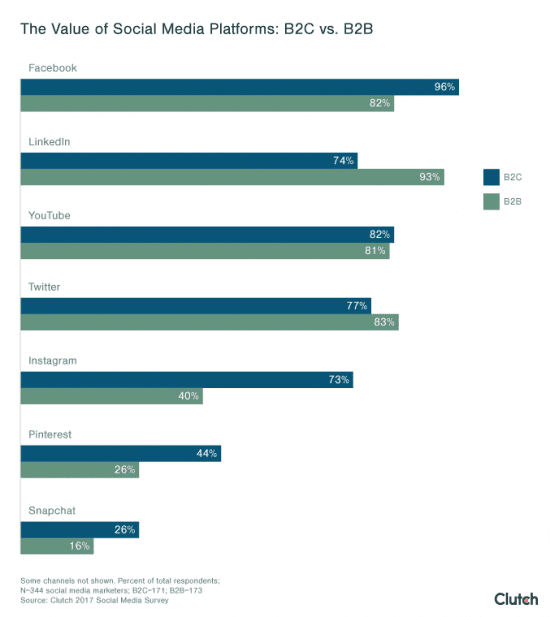We talked to Scott Jaworski, Director of Global Social Media at Intel to find out how Intel manages social media on a global basis
In a recent survey Smart Insights, and Clutch, found that social media usage and effectiveness differs between B2B and B2C companies:
Facebook was found to be the most valuable platform for B2C companies (96%), whilst LinkedIn is the most valuable for B2B companies.
To find out more about trends in managing social media in large global brands, we interviewed Scott Jaworski, Director of Global Social Media at Intel, one of many senior keynote speakers at the Marketing Leadership Forum on October 5-6. We were interested to learn his thoughts on social media trends and innovations, brand identity on social, and mass-communications.
Trends and Innovations
Q1. Which social media trends and new innovations are you tracking which you think will be important for Intel's audiences in 2018?
The most recent ideation session I hadwas focused on camera effects. A unique opportunity for brands, especially through social is directly inside the mobile camera (Facebook's camera effects platform). Combined with augmented reality, it could be a winning recipe where brands help users create new and personalized ways to tell their story.
Q2. To what degree can social media activities be centralized in a global business like yours?
Anything’s possible and I know it sounds dreamy, but we took a pause and asked ourselves these questions first - is it the right thing to do? Are we better served focusing efforts on appointing the right people in the role?
Knowing the end-state goal of your centralized vision can take you down different, potentially easier paths netting the same end result. Example: we firmed up our social handle strategy and did a deep analysis of our footprint. The results that came in showed fragmentation and ways in which we were able to reduce (with limited impact on reach) which indirectly aided in our centralization efforts.
Voice and Brand Identity
Q3. How do look to control tone of voice and brand identity on a global basis?
First and foremost, we needed to know who, the role, level of expertise and where the audience is that creates and publishes our content. This knowledge was integral to the creation, distribution and governance of our brand strategy and guardrails. Knowing the aforementioned, we…
Created strategic documentation
- We developed several versions written for different audiences at varying altitudes – handle owners, agencies, etc.
Distributed
- Created a single destination for hosting. Users have learned where to find the latest and greatest and we can better manage version control and tracking – are people downloading it and who?
Empowered
- Developed a support structure who has skin in the game and ability to apply a layer of localized oversight.
Use Tools
- Leverage editorial planning software. This increased visibility and provided tracking, which organically impacts accountability
Governed
- Implemented a governance team and framework to monitor handles. This was partially automated via the use of tools
To level set, the reality is that this is a continuous challenge that requires regular attention.
Integrating marketing communications
Q4. What is your view on the value of having a content marketing or audience engagement strategy and plan for each business area/market? Should this be defined as a separate document to achieve focus, or integrated into other communications plans?
Social without the “social” is advertising. If we’re looking to strike a rapport, develop relationships (a key differentiator social has over all other forms of marketing) and build an active audience, we need to have an engagement strategy. My POV is that this is the cost of doing business in the social world.
I’d align your engagement strategies with audiences vs. businesses – which lends itself to being internally focused. More challenging than not is having visibility and the opportunity to engage digitally; above and beyond social. Depending on the size and organizational structure of your business, this will likely require cross-BU collaboration, extension into geos (cultural relevance), etc. To the extent of which you can achieve a holistic view, the better.
Social media command center
Q5. A few years back using a 'Social media command center' was seen as a way of showcasing social media and responding to customer issues. What is your view on SMCs?
SMCs of today are more than just customer support centers. They are vital to real-time insights and the development of actionable brand executions; whether it’s helping a customer or joining a relevant conversation. That said, they’re transient by nature; you can quickly ramp and build in support of an event, activation or initiative.
The current generation of SMCs are full on Digital Analytics Hubs. These hubs go above and beyond supporting customer issues and real-time insights. The hubs capabilities include, but are not limited to: executive and brand monitoring, social selling, trend spotting, influencer tracking and more.
Marketing technology apps
Q6. Which marketing technology and apps do you use within to manage communications in-team and with prospects and customers?
Due to contractual sensitivities, I’d prefer not to answer this question citing vendor names.
Generally speaking, my team uses editorial planning, publishing, listening, analytics and collaboration tools.
It’s important to note, there isn’t one tool to do it all. Furthermore, pairing of certain tools can pose other challenges – information sharing/inconsistencies, data integrity, version control, and more – all of which can lead to discrepancies and inefficiencies. Tip: test and iterate often.
Learn more
If you want to know more about social media strategy from Scott, he is one of many senior keynote speakers at the Marketing Leadership Forum on October 5-6.
Registration has just opened for the events, the highest level marketing event taking place this year at the Four Seasons Westlake Village, Malibu, CA on October 5-6.
Features a remarkable line-up of 45+ Marketing Gurus and Experts including:
• David Jaye, Chief Marketing Officer/Chief Digital Officer, IBM
• Christine Nashick, Chief Marketing Officer, DHL Express
• Shonodeep Modak, Chief Marketing Officer, GE Industrial Solutions
• Mark Zarthar, Global Head of Sports Marketing, Anheuser-Busch InBev
• Ted Hutcheson, Vice President, Global Creative and Content, Ashley Furniture Industries
• Rick Wion, Senior Director, Consumer Engagement, Kellogg Company
• Josslyn Mikow, Senior Content Strategist, eBay, Inc
• Ryan Lauder, Director, Customer Engagement, Taylor-Made Adidas Golf
To better understand the event, please click here: http://events.marcusevans-events.com/marketing-leadership-forumna17/
Connect with 80+ CMOs, Heads of Digital, Customer Engagement and Content Strategy Specialists and tailor your personal agenda based on the 4 streamed program.
To apply for a place contact leyanad@marcusevanscy.com
Contact us at leyanad@marcusevanscy.com by September 25 to find out how you can receive a $500 discount off the standard price
source http://www.smartinsights.com/social-media-marketing/social-media-strategy/managing-social-media/


No comments:
Post a Comment